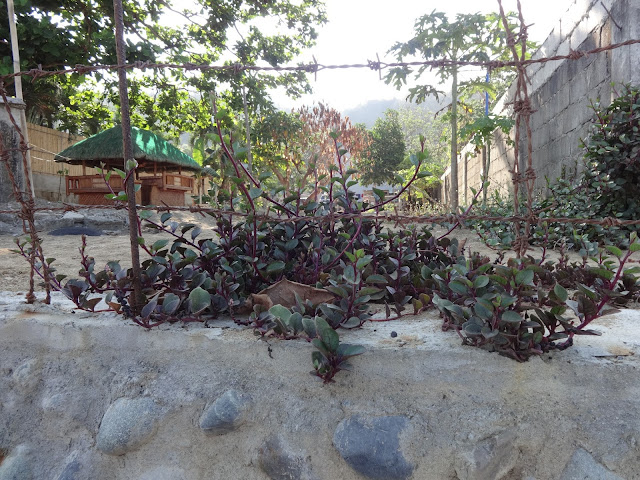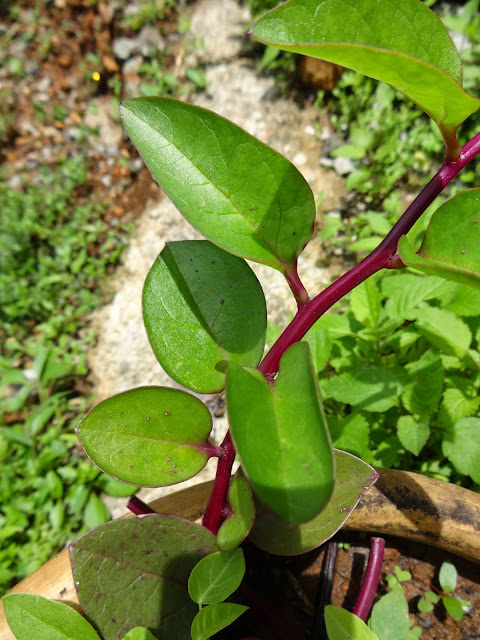 Polska wersja
Polska wersjaPLANT PROFILE
Malabar Spinach is a tropical climbing vine probably native to India's Malabar Coast or Indonesia. It appears in two forms, green one, called in latin Basella alba (alba means white and refer to its white flowers) and Basella rubra (rubra means red) with highly ornamental bordo-red stems and veins of leaves. But lack of other differences in its outlook is bringing those names to be interchanged in use for both varieties together. It is quite popular vegetable in many tropical countries of Asia, Africa and South America. But its scientificaly proven medicinal values are mostly unknown and used mainly in traditional medicine.
It is also called Ceylon Spinach, Indian Spinach, Climbing Spinach, Vine Spinach, Buffalo Spinach, Saan Choy / Shan Tsoi or Lo Kwai / Luo Kai in China, Alugbati / Alogbati in Philippines, Mong Toi in Vietnam, Tsuru Murasa Kai in Japan, Vel Nivithi or Sudu in Sri Lanka, Paag Prang in Thailand, Gambian Spinach or Amunututu or Seje Soro in Nigeria, Jingga or Gendolak in Indonesia, Remayong in Malaysia, Bertalha in Portugal, in India it is called Poi (Hindi), Bacchali / Bachnali (Telugu), Basale (Tulu), Basale Soppu (Kannada), Basalakkirai or Kodip Pasali (Tamil), Mayalu (Marathi), Poi Ni Bhaji (Gujarati), Poi Saaga (Orija), Pui Shak (Bengali), Vashala Cheera ( Malayalam)
It is also called Ceylon Spinach, Indian Spinach, Climbing Spinach, Vine Spinach, Buffalo Spinach, Saan Choy / Shan Tsoi or Lo Kwai / Luo Kai in China, Alugbati / Alogbati in Philippines, Mong Toi in Vietnam, Tsuru Murasa Kai in Japan, Vel Nivithi or Sudu in Sri Lanka, Paag Prang in Thailand, Gambian Spinach or Amunututu or Seje Soro in Nigeria, Jingga or Gendolak in Indonesia, Remayong in Malaysia, Bertalha in Portugal, in India it is called Poi (Hindi), Bacchali / Bachnali (Telugu), Basale (Tulu), Basale Soppu (Kannada), Basalakkirai or Kodip Pasali (Tamil), Mayalu (Marathi), Poi Ni Bhaji (Gujarati), Poi Saaga (Orija), Pui Shak (Bengali), Vashala Cheera ( Malayalam)
CULTIVATION AND HARVESTING
Basella alba / rubra is perennial vine that likes tropical conditions, but is also cultivated as an annual crop in temperate regions. It can climb up or spread horizontally up to 10m and is fairly fast growing as long as temperatures are high. Even though it is climbing/crawling in nature, Basellas young stems are not to flexible and can become quite hard, so it can be shaped into a small bush. It is heat loving plant that can be hurt by temperatures lower than 5'C, and instantly killed with less than 0'C. Its succulent flesh helps it to easily survive severe and long drought with its water storage. It also tolerates heavy rains and high humidity. It likes full sun, but when planted in partial shade its growth is faster and leaves are more juicy. Malabar Spinach grows best in fertile, acidic soils but tolerates even poor, sandy soils. It tiny flowers appear usually in dry seasons followed by black berries. It can be easily propagated from cuttings and seeds, which for faster germination it is advised to be scarificated (scratch its hard shell with pile or sand paper) or soaked in water for 24h before planting. Since there is no difference in growth or taste between red and green variety, I advice you to put some colours in your veggie patch by planting red one. Basella rubra looks so pretty (older leaves can be whole red, stems are always), that it is worth to be planted for pure ornamental purpose also. Leaves and young shoots can be gathered at any time after plant gain some strength and size.

CULINARY USES
Malabar Spinach leaves and young stems are very juicy, crunch and mucilaginous. It can be eaten raw in sandwiches and salads but it's usually steamed, stir-fried or cooked. It can be used in soups and stews as a thickener. Red juice from its fruits is sometimes used as coloring for foods, in China it is sold powderised under name 'Gintjoo' (also used as a dye and ink).
COSMETIC USES
Black fruits of Basella alba and rubra are crushed and used for its pigment as a rouge for cheeks and lips.
Black fruits of Basella alba and rubra are crushed and used for its pigment as a rouge for cheeks and lips.
MEDICINAL USES
Basella alba / rubra have long tradition of use for its nutritious and medicinal values, but even in South-east Asia it seems to be out off mainstream herbalism. Even though there have been many scientifical studies that confirmed its healing actions, its traditional medical applications (Ayurveda and Siddha) are mainly forgotten. In South-east Asia it has been consumed for centuries as a treatment for malaria, melanoma, leukemia and oral cancers, catarrh, mouth ulcers, dysentery, stomach pains, anemia, anorexia, haemoptisis, strangury, sexual weakness, irregular periods, to increase milk production in breastfeeding mothers, and applied topicaly in form of smashed leaves on bruises, wounds, burns, skin inflammations, urticaria, sores, scalds, fungal infections, boils, acne, freckles, pruritic skin lesions, snakebites and on forehead for headaches.
In China it is claimed to reduce fever and neutralize poison. In Nigeria it is used to enhance fertility in women and for hypertension. Juice from fruits is used as eye drops for conjunctivitis. In Kenya leaves are used to treat stomachache and constipation after childbirth. In Cameroon it is taken for malaria. In the Philippines it is used gonorrhea and balanitis.
Malabar Spinach is rich in mucilage and contain betalains, saponins, tannins, cardiac glycosides, flavonoids, terpenoids, sterols, amino-acids, carotenoids, vitamins A, B1, B2, B9, K, E and C, niacin, iron, potassium, manganese, copper, magnesium, zinc and calcium. It acts as emollient, demulcent, cooling, diuretic, tonic, mild laxative, antimicrobial, antifungal, antioxidant, aphrodisiac, antiulcer, rubifacient, androgenic potential, cytotoxic, anticonvulsant, febrifuge, nephroprotective, haemostatic, lactogenic, sedative. Fresh juice is prescribed to ease constipation in children and pregnant women. Basella alba is used in testosterone-boosting supplements, tests on rats proved increase in production of testosterone, estradiol i aromatase mRNA. It is commonly used mixed with Hibiscus macaranthus to increase women fertility. In Ayurvedic system of medicine it is said to aggravate kapha, allievates vata and pita.







Sources
'' Useful Plants of the Philippines '' Volume 3 - William H. Brown, Acorn Press 1950
'' Indian Medicinal Plants '' tom 1 - P. K. Warrier, V. P. K. Nambiar, Orient Blackswan 1994
'' 75 Exciting Vegetables for Your Garden '' - Jack Staub, Gibbs Smith 2009
'' Handbook of Vegetable Science and Technology '' - D. K. Salunkhe, S. S. Kadam, CRC Press 1998
'' Vegetables '' - G. J. H. Grubben, PROTA 2004
'' Oriental Vegetables : The Complete Guide for Gardening Cook '' - Joy Larkom, Kodansha America 2008
'' CRC World Dictionary of Medicinal and Poisonus Plants '' - Umberto Quattrocchi, CRC Press 2012
'' Encyclopaedia of Indian Medicine '' - Saligrama Krishna Ramachandra Rao, Popular Prakashan 1985
'' Underutilized and Underexploited Horticultural Crops '' - K. V. Peter, New India Publishing 2007
'' Vegetable Crops '' - T. R. Gopalakrishnan, New India Publishing 2007
'' African Indigenous Vegetables in Urban Agriculture '' - Charlie M. Shackleton, Margaret W. Pasquini, Alex W. Drescher, Routledge 2009
'' Book of Calories and Phytosterols in Foods '' - Mary Curtis, Lulu.com 2013
http://www.academicjournals.org/article/article1379753858_Kumar%20et%20al.pdf
'' Handbook of Vegetable Science and Technology '' - D. K. Salunkhe, S. S. Kadam, CRC Press 1998
'' Vegetables '' - G. J. H. Grubben, PROTA 2004
'' Oriental Vegetables : The Complete Guide for Gardening Cook '' - Joy Larkom, Kodansha America 2008
'' CRC World Dictionary of Medicinal and Poisonus Plants '' - Umberto Quattrocchi, CRC Press 2012
'' Encyclopaedia of Indian Medicine '' - Saligrama Krishna Ramachandra Rao, Popular Prakashan 1985
'' Underutilized and Underexploited Horticultural Crops '' - K. V. Peter, New India Publishing 2007
'' Vegetable Crops '' - T. R. Gopalakrishnan, New India Publishing 2007
'' African Indigenous Vegetables in Urban Agriculture '' - Charlie M. Shackleton, Margaret W. Pasquini, Alex W. Drescher, Routledge 2009
'' Book of Calories and Phytosterols in Foods '' - Mary Curtis, Lulu.com 2013
http://www.academicjournals.org/article/article1379753858_Kumar%20et%20al.pdf
http://www.sphinxsai.com/2012/july_sept12/Pharm/pdfpharm/PT=02(900-913)JS%2012.pdf
http://www.globinmed.com/index.php?option=com_content&view=article&id=79070:basella-alba-l
http://www.stuartxchange.com/Alugbati.html
http://cagayandeoro.da.gov.ph/wp-content/uploads/2013/04/ALUGBATI.pdf
http://link.springer.com/chapter/10.1007%2F978-3-642-73617-9_3#page-1
http://www.gardening.cornell.edu/homegardening/scene9529.html
http://www.survivalfoodplants.com/malabar-indian-spinach-basella-alba/
http://www.ergo-log.com/basellaalba.html
http://www.ncbi.nlm.nih.gov/pubmed/21339992
http://examine.com/supplements/Basella+alba/
http://www.globinmed.com/index.php?option=com_content&view=article&id=79070:basella-alba-l
http://www.stuartxchange.com/Alugbati.html
http://cagayandeoro.da.gov.ph/wp-content/uploads/2013/04/ALUGBATI.pdf
http://link.springer.com/chapter/10.1007%2F978-3-642-73617-9_3#page-1
http://www.gardening.cornell.edu/homegardening/scene9529.html
http://www.survivalfoodplants.com/malabar-indian-spinach-basella-alba/
http://www.ergo-log.com/basellaalba.html
http://www.ncbi.nlm.nih.gov/pubmed/21339992
http://examine.com/supplements/Basella+alba/
























